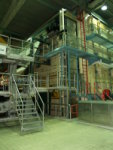
Some of our reference objects

The analysing of the effects of structural fatigue loading, requires high know-how.

Cyclic or changing loading will cause on the structures along the time fatigue cracks that may be fatal for the whole structure.
Structural- and metal-fatigue analysis
The lifespan of a structure is possible to divide into five stages; target defining, structural planning and realization, pilot-run, development, and maintenance. In order to work properly, every structure must meet the certain minimum operational requirements. The operational state of a structure is at its maximum right after the build-up, when a structure, machine or the system is working with the full capacity.
The function failure of a structure causes a process slow-down and even a shut-down.Therefore, this is to be avoided by all possible means. The structural damages may occur due to: wearing out, breakage by overloading, corrosion, very demanding environmental factors or wrong planning.
Metal-fatigue
One of the most current breakage is due to the metal-fatigue. Fatigue is a process, which causes deterioration and breakage of a metallic material due to the repeated strain and strechting.
The most common reason for fatigue problems is inadequate fatigue planning, maintenance errors or pure ignorance. A small initial breakage point may seem rather harmless, but the breakage point grows in an accelerated way, and weakens the structural strength very quickly, while the breakage gets larger and larger.
The scope of the fatigue-problematic structures is very wide. Here few examples:
- Steel bridges, especially railway bridges, as the train traffic loading is very heavy.
- Debarking drums of wood industry, chipping drums, and other heavily loaded rotating structures.
- Off-Shore structures and ship-hulls due to the loading caused by the waves.
- The components of space-shuttles and planes due to high cyclical loadings.
- The components of cars and trains.
- Rails and their installation components.
- Pipelines subject to pressure, heat-extension- and shrinking.
- Various bolted joints, where bolts are subject to cyclic tensile strength.
- Cranes and hoisting devices.
- Beams of overhead bridges.
- Parts of the protheses.
Measuring
eMES-method is able to carry out a real time fatigue-analysis of a structure. To do this, we will install at a structure special sensors to measure eventual stretching caused by the cyclic loadings. In principle, almost all the fatigue-critical structures, machines, and vehicles may be measured, studied, and surveyed by using eMES-method.
Analysis and evaluation
eMES-method program is able to apply complex analysismethods to the measured data on real time.
The method may carry out the structural fatigue-analysis, including a life-span calculation.
At the same time it is possible to do also the structural static analysis. The analysis results are simple and clear: the remaining life-time of a structure, the structural safety coefficients, repair recommendations, and maintenance instructions.
As a summary we can say that the life span of a structure normally ends due to a physical damage or a technological outdating.



 P.O. Box 137, 53101 Lappeenranta, Finland | matti.taipale@emering.fi | tel +358 50 495 0015 | fax +358 55 411 399
P.O. Box 137, 53101 Lappeenranta, Finland | matti.taipale@emering.fi | tel +358 50 495 0015 | fax +358 55 411 399